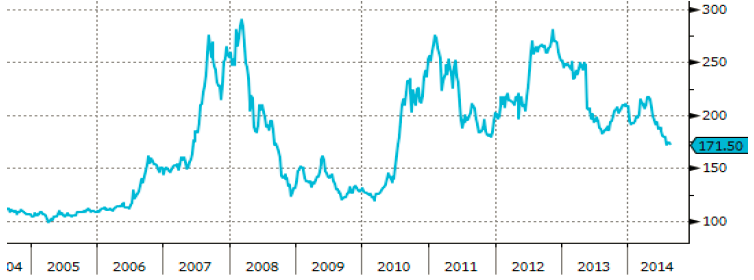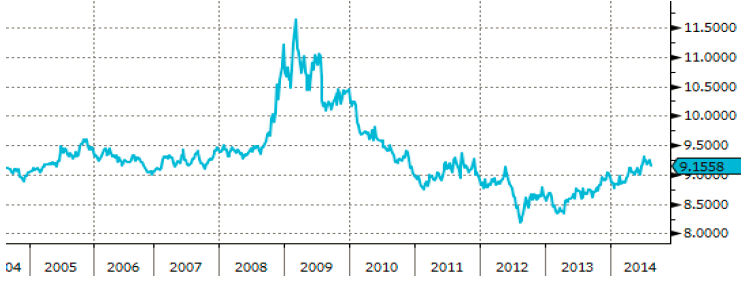Analys
Handelsbanken Jordbruk, 22 augusti 2014
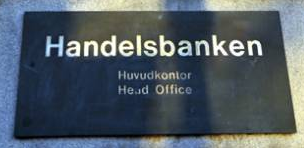
Skörd 2015
Spannmålspriserna har gått ned en hel del under det gångna året – en följd av globala rekordskördar på alla de tre stora grödorna vete, majs och sojabönor. Även 2013 var volymmässigt ett bra skördeår och 2014 blir andra året på raken med relativt stor lageruppbyggnad. Vete MATIF november 14 handlas i skrivande stund på EUR 171 (SEK 1.565) per ton – så sent som i april i år var samma kontrakt uppe på EUR 210 (SEK 1.985) per ton. Under 2013 handlades november 14-kontraktet stundtals ännu högre.
Vad vi upplever just nu är att lantbrukare som för nästa års skörd istället köper på termin (spekulerar i en prisuppgång och ökar sin risk) till antalet är klart fler än de lantbrukare som säljer på termin (skyddar sig mot ytterligare prisfall). Om det var djurproducenter som prissäkrade kommande foderinköp vore det mer förståeligt – men så är inte fallet, få av dessa har vaknat på samma sätt. Om denna riskvilja lönar sig vet ingen, främst bör det bero på huruvida väderproblem uteblir i världens större spannmålsregioner även under 2015 eller ej – om inte finns det skäl att tro att priserna kan pressas ytterligare nedåt.
Grafen nedan visar närmsta rullande termin på MATIF för de senaste tio åren – med tre väldigt tydliga pristoppar, intressant nog alla på nästan samma nivå.
- 2006-07 ökade spannmålspriserna kraftigt som följd av minskad global produktion i kombination med ökad efterfrågan inte minst som energigröda.
- Efter att vete MATIF handlats ned mot EUR 120 per ton fick vi sommaren 2010 återigen en kraftig prisuppgång – värme och torka gjorde att ryska vetefält praktiskt taget brann upp, varpå Ryssland senare införde exportförbud av spannmål i syfte att dämpa inhemsk inflation.
- 2012 blev allt annat än problemfritt – Ryssland fick ännu lägre veteskörd än 2010, den amerikanska majsen upplevde den värsta torkan på över 50 år och jämfört med året innan föll produktionen i varierande grad i Europa, Australien och Sydamerika.
Kort sagt – vi har de senaste åren haft kraftiga prisuppgångar och även ett högt genomsnittspris men inte utan anledning.
Decemberterminen vete MATIF 2015 handlas just nu kring EUR 186 (SEK 1.705) per ton – en nivå som alltså verkar locka mer till köp än sälj även för producenter. Med ögonen på ovanstående vetegraf, med klart lägre nivåer bara för några få år sedan, kan det ses som förvånande att riskviljan är så stor. Märk väl att Handelsbankens vy inte är att priserna ska falla ytterligare, vi håller för tillfället en neutral vy i väntan på mer prognoser om höstsådden och potential för nästa års skörd men också i en tid av hög politisk oro där utfallet är svårt att sia om. Däremot är vi väldigt säkra på att risken för ytterligare prisfall åtminstone existerar.
Vad man heller inte bör bortse från är att EUR/SEK under perioden med låga spannmålspriser kring 2009 stundtals handlades bra mycket högre än idag, se graf nedan. En svag svensk krona i förhållande till euron gynnar svenska spannmålspriser och givetvis tvärtom. Handelsbankens prognos för EUR/SEK under det fjärde kvartalet 2015 är 8,75 – ganska väl i linje med de europeiska storbankernas snittprognos. Faller dessa prognoser in bör det alltså pressa ned svenska inhemska spannmålspriser.
Det är bråda dagar för landets spannmålsbönder, årets skörd är långt ifrån klar på många håll i landet – tyvärr med stora nederbördsrelaterade problem i inte minst i Halland och Västergötland. Och efter skörd ska det sås. Ändock kan det finnas skäl att, om inte annat när regnet faller och tröskan står stilla, fundera på hur riskerna kring nästa års skörd ska hanteras. Är verkligen dessa EUR 186 (SEK 1.705) per ton för lågt för att sälja ens en liten del? Kanske är säljoptioner intressant i detta läge – med vilka ett skydd mot fallande priser ges samtidigt som möjlighet att ta del av eventuell uppsida finns kvar. På nästföljande sidor följer några exempel med säljoptioner vete MATIF september 2015 för den som är intresserad.
Säljoptioner ger ibland ett bättre utfall än terminer och ibland tvärtom. Då produktionsnivån inte är helt säker bör heller inte hela volymen prissäkras. En kombination av dessa tre val är kanske det rätta. En tredjedel i varje är ett möjligt alternativ – med då två tredjedelar skyddat mot prisfall och två tredjedelar med möjlighet till att ta del av prisuppgång.
Säljoptioner
En säljoption ger innehavaren en rättighet men inte en skyldighet att få sälja underliggande termin* till en viss förbestämd prisnivå (lösenpris) – vilket innebär att om terminspriset handlas över lösenpriset utnyttjar innehavaren inte sin säljoption och kan istället dra nytta av ett högre försäljningspris för fysisk vara. Ett köp av en option kommer aldrig kosta köparen mer än kostnaden för optionen, den s.k. premien.
*Vid affär med Handelsbanken hanterar banken försäljning och köp på börsen och betalar mellanskillnaden direkt till kund.
Följande visar exempel på möjligheter inför skörd 2015:
Lösenpriset kan köparen välja själv och kan således vara både högre och lägre än i ovanstående exempel. Som synes kommer premien variera efter valt lösenpris – en säljoption med ett högre lösenpris kostar mer än en säljoption med ett lägre lösenpris. Oavsett lösenpris finns inga fasta nivåer på premien utan dessa beräknas vid varje affärstillfälle då nivån på dessa även är beroende av främst löptid och volatiliteten på underliggande terminskontrakt. Löptiden är nu relativt lång, men allt annat lika blir alltså dessa optioner billigare med tiden.
Antag att en lantbrukare köper den säljoption som i exemplet ovan har lösenpriset SEK 1.700 per ton och betalar premien SEK 137 per ton. Utfallet av denna affär om optionen behålls till förfallodatum blir då som följer utifrån några olika scenarion – vetepriset faller 20 procent, förblir oförändrat eller stiger 20 procent:
Vi antar i dessa exempel ett fysiskt vetepris som är exakt i nivå med terminspriset på MATIF.
Det kan tilläggas att köparen av en säljoption kan välja att sälja tillbaka optionen när som helst innan löptidens slut, alltså i detta fall innan den 17:e augusti.
Huruvida säljoptioner är ett mer attraktivt instrument att skydda sig mot ett prisfall än terminer finns det inget stående svar på, det varierar inte minst utifrån rådande prisnivå – dels på vetet och dels på prmien. I ovanstående utfall vore terminer en bättre lösning då priset föll och då priset var oförändrat – givetvis som följd av kostnaden för premien. Men när priset stiger kan en säljoption alltså bli ett klart mer fördelaktigt val, utan av ge avkall på skydd mot nedsida.
Om lantbrukaren tycker att premien i ovanstående exempel är dyr kan en option med ett lägre lösenpris väljas. Nedanstående tabell visar utfallet med samma tre scenarion som ovan om säljoptionen med lösenpriset SEK 1.650 per ton valts:
Som vi ser blev resultatet här något bättre i de fall då priset förblev oförändrat eller steg – som följd av att premien i detta fall var lägre med SEK 114 mot SEK 137. Dock var inte skyddet mot ett prisfall lika starkt, p.g.a. ett lägre lösenpris, och utfallet då priset föll blev alltså sämre.
Fördelen med att istället välja ett högre lösenpris är att skyddet mot nedsidan blir starkare – dock till en högre kostnad. Nedanstående tabell visar utfallet för den dyraste av säljoptionerna av de tre alternativen i tabell 1, den med lösenpriset SEK 1.750 per ton.
Som synes gav ett högre lösenpris med tillhörande högre premie ett bättre resultat när priset föll på bekostnad av en mer begränsad uppsida.
[box]Handelsbanken Jordbruk är producerat av Handelsbanken och publiceras i samarbete och med tillstånd på Råvarumarknaden.se[/box]
Ansvarsbegränsning
Detta material är producerat av Svenska Handelsbanken AB (publ) i fortsättningen kallad Handelsbanken. De som arbetar med innehållet är inte analytiker och materialet är inte oberoende investeringsanalys. Innehållet är uteslutande avsett för kunder i Sverige. Syftet är att ge en allmän information till Handelsbankens kunder och utgör inte ett personligt investeringsråd eller en personlig rekommendation. Informationen ska inte ensamt utgöra underlag för investeringsbeslut. Kunder bör inhämta råd från sina rådgivare och basera sina investeringsbeslut utifrån egen erfarenhet.
Informationen i materialet kan ändras och också avvika från de åsikter som uttrycks i oberoende investeringsanalyser från Handelsbanken. Informationen grundar sig på allmänt tillgänglig information och är hämtad från källor som bedöms som tillförlitliga, men riktigheten kan inte garanteras och informationen kan vara ofullständig eller nedkortad. Ingen del av förslaget får reproduceras eller distribueras till någon annan person utan att Handelsbanken dessförinnan lämnat sitt skriftliga medgivande. Handelsbanken ansvarar inte för att materialet används på ett sätt som strider mot förbudet mot vidarebefordran eller offentliggörs i strid med bankens regler.
Analys
OPEC+ will likely unwind 500 kb/d of voluntary quotas in October. But a full unwind of 1.5 mb/d in one go could be in the cards

Down to mid-60ies as Iraq lifts production while Saudi may be tired of voluntary cut frugality. The Brent December contract dropped 1.6% yesterday to USD 66.03/b. This morning it is down another 0.3% to USD 65.8/b. The drop in the price came on the back of the combined news that Iraq has resumed 190 kb/d of production in Kurdistan with exports through Turkey while OPEC+ delegates send signals that the group will unwind the remaining 1.65 mb/d (less the 137 kb/d in October) of voluntary cuts at a pace of 500 kb/d per month pace.

Signals of accelerated unwind and Iraqi increase may be connected. Russia, Kazakhstan and Iraq were main offenders versus the voluntary quotas they had agreed to follow. Russia had a production ’debt’ (cumulative overproduction versus quota) of close to 90 mb in March this year while Kazakhstan had a ’debt’ of about 60 mb and the same for Iraq. This apparently made Saudi Arabia angry this spring. Why should Saudi Arabia hold back if the other voluntary cutters were just freeriding? Thus the sudden rapid unwinding of voluntary cuts. That is at least one angle of explanations for the accelerated unwinding.
If the offenders with production debts then refrained from lifting production as the voluntary cuts were rapidly unwinded, then they could ’pay back’ their ’debts’ as they would under-produce versus the new and steadily higher quotas.
Forget about Kazakhstan. Its production was just too far above the quotas with no hope that the country would hold back production due to cross-ownership of oil assets by international oil companies. But Russia and Iraq should be able to do it.
Iraqi cumulative overproduction versus quotas could reach 85-90 mb in October. Iraq has however steadily continued to overproduce by 3-5 mb per month. In July its new and gradually higher quota came close to equal with a cumulative overproduction of only 0.6 mb that month. In August again however its production had an overshoot of 100 kb/d or 3.1 mb for the month. Its cumulative production debt had then risen to close to 80 mb. We don’t know for September yet. But looking at October we now know that its production will likely average close to 4.5 mb/d due to the revival of 190 kb/d of production in Kurdistan. Its quota however will only be 4.24 mb/d. Its overproduction in October will thus likely be around 250 kb/d above its quota with its production debt rising another 7-8 mb to a total of close to 90 mb.
Again, why should Saudi Arabia be frugal while Iraq is freeriding. Better to get rid of the voluntary quotas as quickly as possible and then start all over with clean sheets.
Unwinding the remaining 1.513 mb/d in one go in October? If OPEC+ unwinds the remaining 1.513 mb/d of voluntary cuts in one big go in October, then Iraq’s quota will be around 4.4 mb/d for October versus its likely production of close to 4.5 mb/d for the coming month..
OPEC+ should thus unwind the remaining 1.513 mb/d (1.65 – 0.137 mb/d) in one go for October in order for the quota of Iraq to be able to keep track with Iraq’s actual production increase.
October 5 will show how it plays out. But a quota unwind of at least 500 kb/d for Oct seems likely. An overall increase of at least 500 kb/d in the voluntary quota for October looks likely. But it could be the whole 1.513 mb/d in one go. If the increase in the quota is ’only’ 500 kb/d then Iraqi cumulative production will still rise by 5.7 mb to a total of 85 mb in October.
Iraqi production debt versus quotas will likely rise by 5.7 mb in October if OPEC+ only lifts the overall quota by 500 kb/d in October. Here assuming historical production debt did not rise in September. That Iraq lifts its production by 190 kb/d in October to 4.47 mb/d (August level + 190 kb/d) and that OPEC+ unwinds 500 kb/d of the remining quotas in October when they decide on this on 5 October.
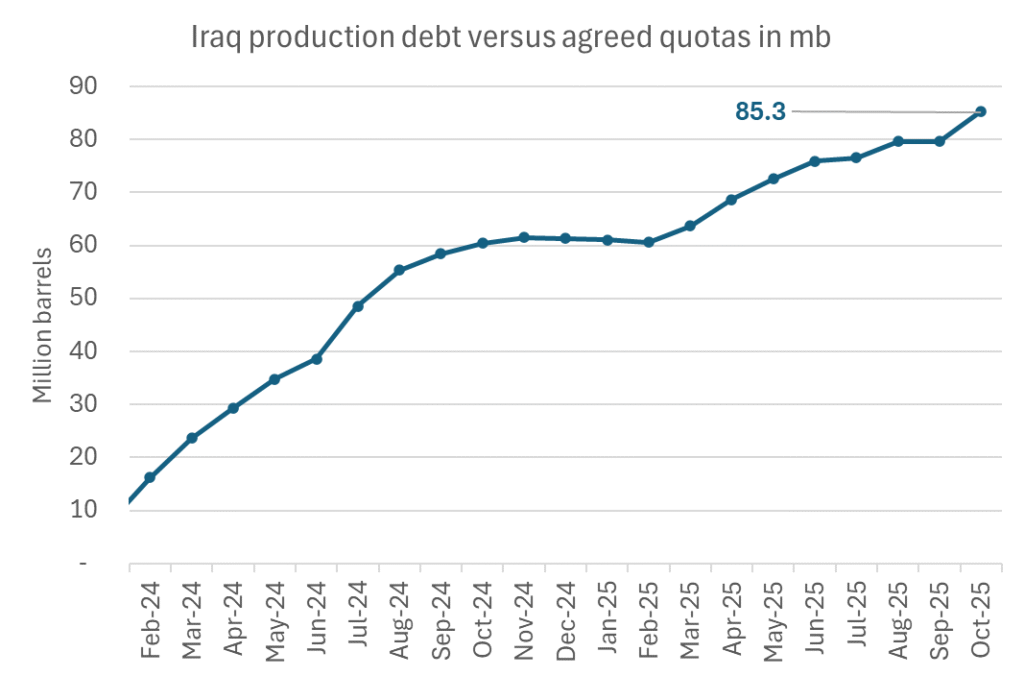
Analys
Modest draws, flat demand, and diesel back in focus

U.S. commercial crude inventories posted a marginal draw last week, falling by 0.6 million barrels to 414.8 million barrels. Inventories remain 4% below the five-year seasonal average, but the draw is far smaller than last week’s massive 9.3-million-barrel decline. Higher crude imports (+803,000 bl d WoW) and steady refinery runs (93% utilization) helped keep the crude balance relatively neutral.

Yet another drawdown indicates commercial crude inventories continue to trend below the 2015–2022 seasonal norm (~440 million barrels), though at 414.8 million barrels, levels are now almost exactly in line with both the 2023 and 2024 trajectory, suggesting stable YoY conditions (see page 3 attached).
Gasoline inventories dropped by 1.1 million barrels and are now 2% below the five-year average. The decline was broad-based, with both finished gasoline and blending components falling, indicating lower output and resilient end-user demand as we enter the shoulder season post-summer (see page 6 attached).
On the diesel side, distillate inventories declined by 1.7 million barrels, snapping a two-week streak of strong builds. At 125 million barrels, diesel inventories are once again 8% below the five-year average and trending near the low end of the historical range.
In total, commercial petroleum inventories (excl. SPR) slipped by 0.5 million barrels on the week to ish 1,281.5 million barrels. While essentially flat, this ends a two-week streak of meaningful builds, reflecting a return to a slightly tighter situation.
On the demand side, the DOE’s ‘products supplied’ metric (see page 6 attached), a proxy for implied consumption, softened slightly. Total demand for crude oil over the past four weeks averaged 20.5 million barrels per day, up just 0.9% YoY.
Summing up: This week’s report shows a re-tightening in diesel supply and modest draws across the board, while demand growth is beginning to flatten. Inventories remain structurally low, but the tone is less bullish than in recent weeks.
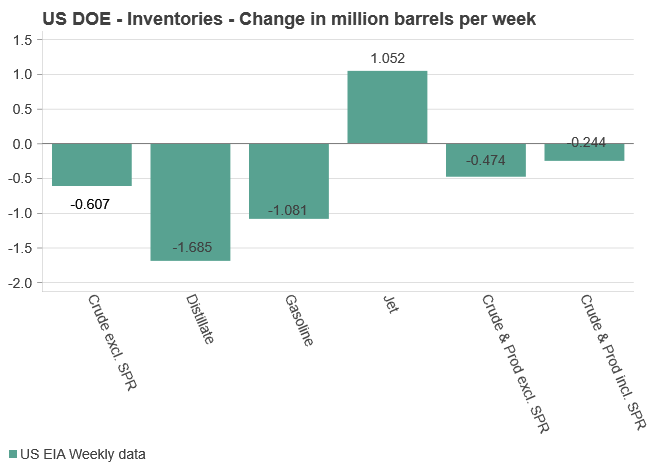
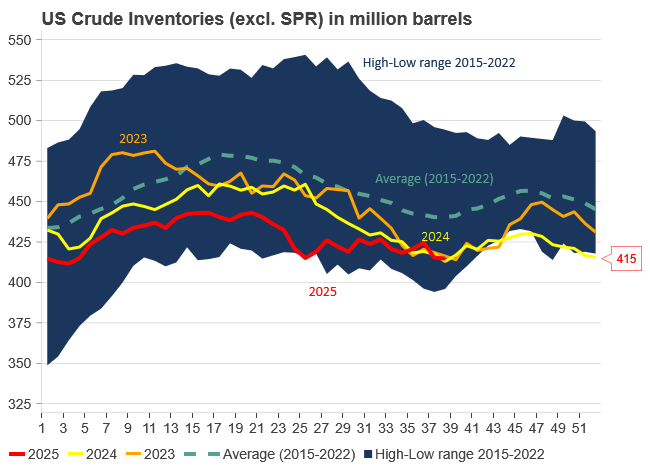
Analys
Are Ukraine’s attacks on Russian energy infrastructure working?

Brent crude rose 1.6% yesterday. After trading in a range of USD 66.1 – 68.09/b it settled at USD 67.63/b. A level which we are well accustomed to see Brent crude flipping around since late August. This morning it is trading 0.5% higher at USD 68/b. The market was expecting an increase of 230 kb/d in Iraqi crude exports from Kurdistan through Turkey to the Cheyhan port but that has so far failed to materialize. This probably helped to drive Brent crude higher yesterday. Indications last evening that US crude oil inventories likely fell 3.8 mb last week (indicative numbers by API) probably also added some strength to Brent crude late in the session. The market continues to await the much heralded global surplus materializing as rising crude and product inventories in OECD countries in general and the US specifically.

The oil market is starting to focus increasingly on the successful Ukrainian attacks on Russian oil infrastructure. Especially the attacks on Russian refineries. Refineries are highly complex and much harder to repair than simple crude oil facilities like export pipelines, ports and hubs. It can take months and months to repair complex refineries. It is thus mainly Russian oil products which will be hurt by this. First oil product exports will go down, thereafter Russia will have to ration oil product consumption domestically. Russian crude exports may not be hurt as much. Its crude exports could actually go up as its capacity to process crude goes down. SEB’s Emerging Market strategist Erik Meyersson wrote about the Ukrainian campaign this morning: ”Are Ukraine’s attacks on Russian energy infrastructure working?”. Phillips P O’Brian published an interesting not on this as well yesterday: ”An Update On The Ukrainian Campaign Against Russian Refineries”. It is a pay-for article, but it is well worth reading. Amongst other things it highlights the strategic focus of Ukraine towards Russia’s energy infrastructure. A Ukrainian on the matter also put out a visual representation of the attacks on twitter. We have not verified the data representation. It needs to be interpreted with caution in terms of magnitude of impact and current outage.
Complex Russian oil refineries are sitting ducks in the new, modern long-range drone war. Ukraine is building a range of new weapons as well according to O’Brian. The problem with attacks on Russian refineries is thus on the rise. This will likely be an escalating problem for Russia. And oil products around the world may rise versus the crude oil price while the crude oil price itself may not rise all that much due to this.
Russian clean oil product exports as presented by SEB’s Erik Meyersson in his note this morning.
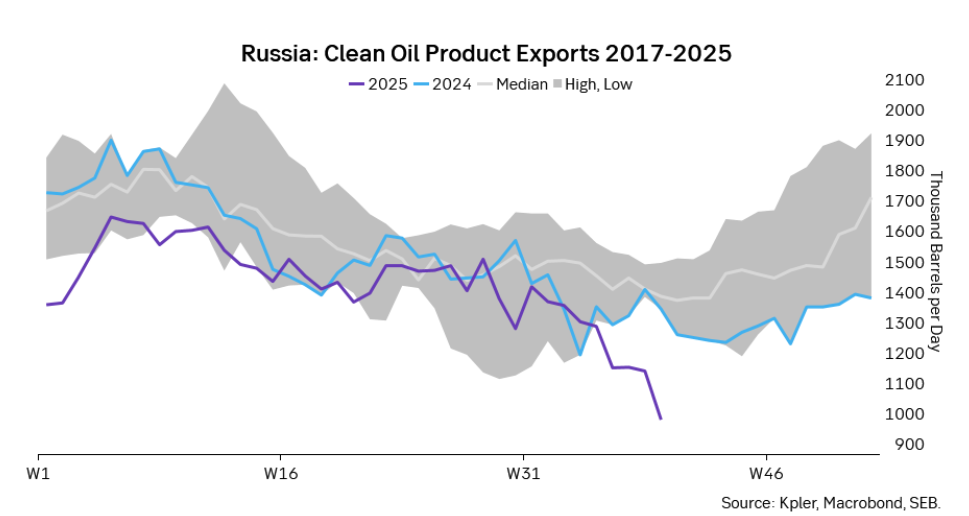
The ICE Gasoil crack and the 3.5% fuel oil crack has been strengthening. The 3.5% crack should have weakened along with rising exports of sour crude from OPEC+, but it hasn’t. Rather it has moved higher instead. The higher cracks could in part be due to the Ukrainian attacks on Russian oil refineries.
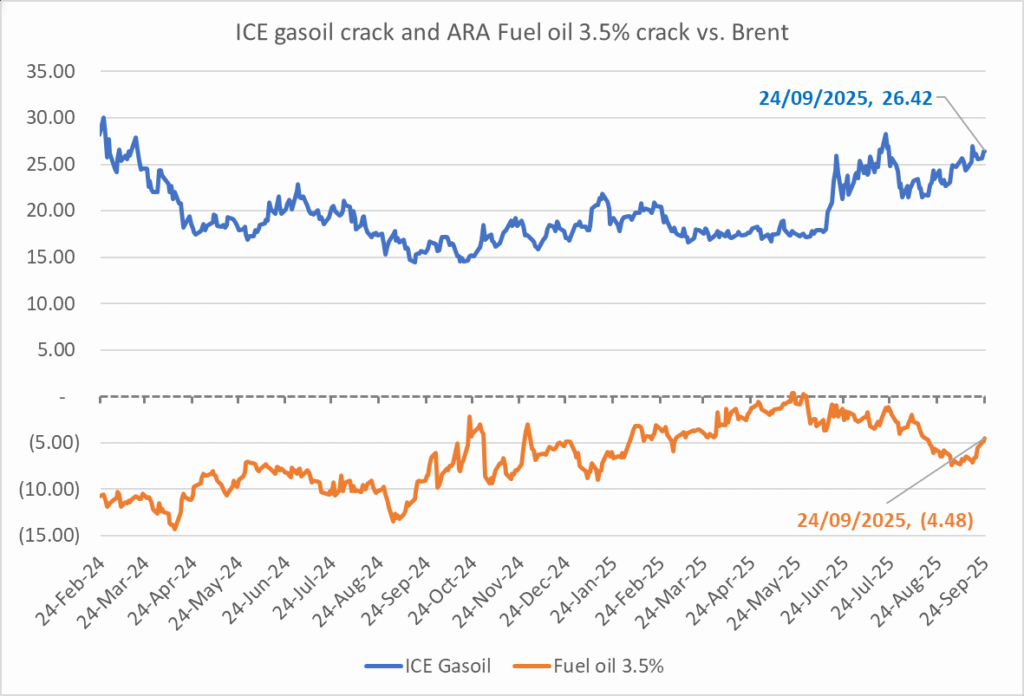
Ukrainian inhabitants graphical representation of Ukrainian attacks on Russian oil refineries on Twitter. Highlighting date of attacks, size of refineries and distance from Ukraine. We have not verified the detailed information. And you cannot derive the amount of outage as a consequence of this.

-

 Nyheter4 veckor sedan
Nyheter4 veckor sedanEurobattery Minerals satsar på kritiska metaller för Europas självförsörjning
-

 Nyheter3 veckor sedan
Nyheter3 veckor sedanMahvie Minerals i en guldtrend
-

 Nyheter4 veckor sedan
Nyheter4 veckor sedanGuldpriset kan närma sig 5000 USD om centralbankens oberoende skadas
-

 Nyheter4 veckor sedan
Nyheter4 veckor sedanOPEC signalerar att de inte bryr sig om oljepriset faller kommande månader
-
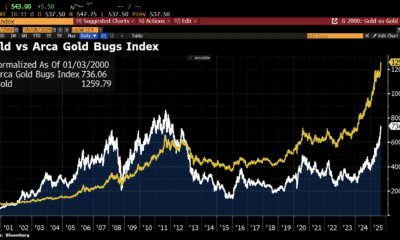
 Nyheter3 veckor sedan
Nyheter3 veckor sedanAktier i guldbolag laggar priset på guld
-

 Analys3 veckor sedan
Analys3 veckor sedanVolatile but going nowhere. Brent crude circles USD 66 as market weighs surplus vs risk
-

 Nyheter2 veckor sedan
Nyheter2 veckor sedanKinas elproduktion slog nytt rekord i augusti, vilket även kolkraft gjorde
-

 Nyheter2 veckor sedan
Nyheter2 veckor sedanTyskland har så höga elpriser att företag inte har råd att använda elektricitet


